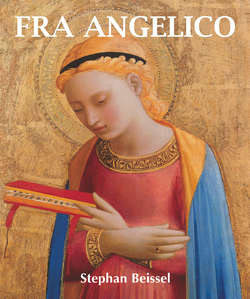Fra Angelico

Реклама. ООО «ЛитРес», ИНН: 7719571260.
Оглавление
Stephan Beissel. Fra Angelico
Fra Angelico’s Early Training and his Work in Cortona and Perugia
Stay and Work in Fiesole
Fra Angelico’s Stay in Florence, and his Murals at the Convento di San Marco
Outside Influences
The Paintings of the Last Judgment and their Relationship with Dante’s Poetry
The Virgin Mary in the Paintings of Fra Angelico
Works in Rome and Orvieto
The Final Years and Death of Fra Angelico
Bibliography
Отрывок из книги
1. Annunciatory Angel, 1450–1455. Tempera and gold on wood panel, 33 × 27 cm. The Detroit Institute of Arts, Detroit.
2. The Annunciation (depicted in an historied initial “R”, detail from a missel), c. 1423. Biblioteca del convento di San Marco, Florence.
.....
The border of each of these paintings shows a text from the Old Testament above and a text from the Gospels below. The influence of the tradition that inspired “The Poor Man’s Bible” (Biblia Pauperum) is visible in these paintings, and it would be useful to briefly examine them and their inscriptions from the point of view of Christian iconography.
1. A sort of preface, this composition represents faith’s written sources and brings together ancient prototypes. Three concentric circles are painted in a square frame. This layout results in four sections: the area outside of the circles and a large wheel enclosing a second smaller wheel. Inside the smaller wheel are the authors of the New Testament: the four Apostles who wrote the Epistles holding banners upon which texts are written, and between them, the four Evangelists. Each of the Evangelists holds a book to his chest, and has his evangelical symbol in the place of his head. In the larger wheel, Angelico painted twelve authors of the Old Testament. At the top is Moses between David and King Solomon, followed by the four “major Prophets” and five of the “minor Prophets”. Jonas is characterised by a fish he holds in his hand. In the bottom corners outside of the wheels are Ezekiel to the left, and Saint Gregory the Great to the right. Between them spreads a banner, which reads Flumen Chobar, for it was on the banks of the Chobar River that the prophet Ezekiel saw the four evangelical animals. In the upper corners of the painting are texts taken from the Book of Ezekiel (1:4) and the homilies of Saint Gregory on Ekekiel’s vision. (See Hom. 2 et 3 in Ezechiel, Opoera ed. Cong. S. Mauri, 1705, I.)
.....